Do Not Panic
Mere weeks before we moved cross country to our new Arizona homestead, Shawn and I were lucky enough to catch a special on the Discovery Channel all about creepy crawly things in Arizona that can kill you. The timing was uncanny. I forget the exact title of the program, but I’m fairly sure it included the words “certain,” “death,” and “John and Shawn from Massachusetts.” The show highlighted Africanized Killer Bees, Black Widow and Brown Recluse Spiders, Scorpions, Tarantulas, Gila Monsters, Javelinas, and Snakes. Lots and lots of snakes. Since neither Shawn nor I had been to Arizona before, the show served as something of a hysteria-inducing introduction to the Southwest, inspiring many an internet search with key terms such as “snake+death+arizona” and “bees+killer+arizona.”
Being intrepidly courageous as well as startlingly attractive, we were not about to let a few hundred species of belly-crawling, neurotoxic organisms deter us from new, almost randomly selected, horizons. We were (and still are) men, not the mice constituting the diets of snakes, scorpions, and tarantulas. As men, we had honor and a non-refundable deposit on a moving truck to defend. We had seen the fanged, venomous face of death, and it was scaly and hairy. It was time to go laugh in it.
Part 1
Bees, Killer

Once, when I was but a mere scrap of a lad cavorting at a picnic, I reached for my can of soda and took the kind of thirst quenching chug you often see in slow motion close-ups in Coke commercials. I don’t remember how refreshing the beverage was, though. I was distracted by an odd lump suddenly present in my mouth; leathery, kind of squishy, and intermittently pointy. I quickly did the kind of reverse-chug you almost never see Coke commercials, expelling, along with copious amounts of Coke, a bee. A yellow jacket, to be precise. The alternating yellow and black bands of its segmented body are still vividly burned into my memory, as are the wet and broken wings of the thing. It was quite dead, which was lucky; during the random, often waylaid course of what I loosely call “fact checking” for this blog, I learned that people can and sometimes do die from stings to the tongue or throat inflicted by a bee introduced in the very same manner. The stings cause the airways to swell and close, and the joys of suffocation follow. All I knew then, though, was that a dead bee had been in my mouth. I have never been more disgusted by anything that has ever happened to me before or since.
I hate bees. Hate them, hate them, hate them. I tend to make a public spectacle of myself when menaced by a bee, “menaced” being a loosely interpretable term which could easily mean, “Happens to be flying by within 10 yards of me.” Single, meandering bees are small and hard to see from a distance, so how my sudden leaping up from a bench and subsequent erratic flailing and swatting is interpreted by others is anyone’s guess.
“Say Bob, what’s with that guy over there?”
“Beats me. Could be a seizure. Or some kind of primitive mating ritual.”
“Well, it is strangely alluring.”
“Just keep walking and avoid eye contact.”
The Africanized Honey Bee, or “Killer Bee,” came into existence in 1957, when African honey bees were imported to Brazil by political activist and science-guy Dr. Warwick Kerr. European honey bees had been imported to Brazil some time before, but didn’t hold up well in the tropics. They lounged about lethargically fanning themselves with bits of banana leaf and complaining about the humidity. The idea was to come up with a cross between the African and European strains that would be as “docile” as the European bee, and as hardy in warm climates as the African bee. However, the early hybrid honey bees escaped from Dr. Kerr and began to mate with local European honey bees unchecked, giving European honey bees a reputation for being “easy” and creating the Africanized Honey Bee as we know him today.
“Africanized bees acquired the name ‘killer bees’ because they will viciously attack people and animals who unwittingly stray into their territory, often resulting in serious injury or death. It is not necessary to disturb the hive itself to initiate an AHB attack. In fact, Africanized bees have been known to respond viciously to mundane occurrences, including noises or even vibrations from vehicles, equipment and pedestrians. Though their venom is no more potent than native honey bees, Africanized bees attack in far greater numbers and pursue perceived enemies for greater distances. Once disturbed, colonies may remain agitated for 24 hours, attacking people and animals within a range of a quarter mile from the hive.”
The Killer Bee is spreading at a rate of 200 miles per year. Hidalgo, Texas, was the first US territory to report killer bees in 1990. By 1993 they had moved into Arizona and New Mexico, and by 1994 colonies were firmly established in California. They’ve been seen as far north as Montana, but the colder climate prohibits colonization. The bees made their first eastward appearance in 1999, traveling along the Gulf of Mexico into Florida.
“On July 15, 1993, 82-year-old Lino Lopez became the first person to die in the U.S. from Africanized honey bee stings. He was stung more than 40 times while trying to remove a colony from a wall in an abandoned building on his ranch near Harlingen, Texas.”
“Arizona's first human fatality from Africanized bees occurred in October, 1993 when 88-year-old Apache Junction woman disturbed a large Africanized honey bee colony in an abandoned building on her property and was stung numerous times.”
Killer bees are said to be “less selective” about areas they colonize than the European honey bee, which means that killer bees will move in just about anywhere--sheds, woodpiles, junk heaps, hideous little duplexes on the West Side--and it’s this “slumming” behavior that puts them in closer and closer contact with human beings. As of 2000, they covered over 5 million square miles of land, and their numbers increase as they infiltrate more and more native colonies.
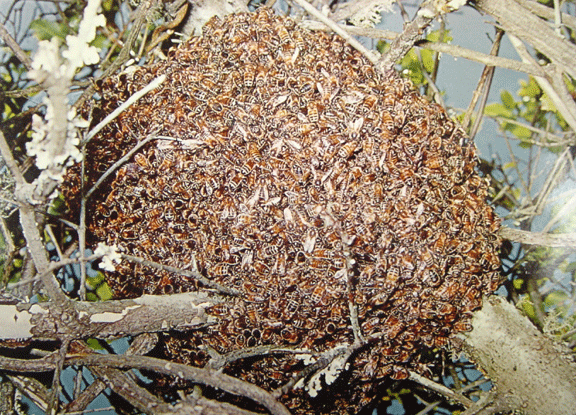
The bees are captivated by the subtle, sophisticated aroma of Elizabeth Taylor’s “White Diamonds” or “Aqua Velva.” They also like the smell of freshly mown grass, which doesn’t say much for Elizabeth Taylor. Bohemian types who only wear black are at a distinct disadvantage, as are those of you with long black tresses. Scientists refer to the bee’s “behavior of attacking dark things” as “a behavior of attacking dark things.” I know scientific jargon can be confusing, but do try to keep up.

Under attack from a swarm of killer bees? Bee Prepared! (Get it? I’m so clever! Actually, I stole that from www.desertusa.com, your one-stop source for all things desert. I could never be that clever.)
• Do not panic.
• Quickly get into a house, car, tent, bubble or other enclosure, provided your idea of an enclosure isn’t closing the garden gate and shouting “Nyah nyah nyah! You can’t come on my property! I’ll call the police!” Once inside the enclosure (I’m calling my car an “enclosure” from now on), close any doors or windows. Bees are not vampires. They’ll come in even if you don’t invite them, and studies about the effectiveness of crucifixes used against them have proven inconclusive.
• Do not jump, dive, “cannonball,” “belly flop” or slide into a pool. The bees will wait until you surface for air to attack, thus initiating a deadly game of “Marco Polo,” during which the bees will almost certainly cheat.
• If you are attacked by bees, run away. Don't play dead or swat at the bees. If playing dead is your best line of defense, you’re either very lazy or a complete idiot (though, frankly, if you can play dead convincingly while being stung hundreds of times, especially in the face, you’d win my momentary admiration). Most people can outrun the bees, but you might have to run a few blocks. Do not wait for a bus.
• Remove stingers as soon as possible to lessen the amount of venom entering the body. Scrape stingers off the skin with a blunt instrument or plastic card. Do not remove bee stingers with fingers or tweezers – this only forces toxins into the victim's body. Remember too that a honeybee can sting only once, since its stinger is barbed and remains embedded in the skin. You have some degree of satisfaction in knowing that the bee leaves behind a good a part of its entrails along the stinger, and so it too will die. But then, you also have the added disgust of being covered in bee guts.
The A.M.A has estimated that 7 stings per pound of body weight is lethal for healthy people without a pre-existing allergy to bee venom. For your average adult, that’s over 1,000 stings. They also kill cattle. Your average cow can weight anywhere from 500 to 1,000 pounds, which paints a pretty scary picture of the size of a swarm. I can’t find an exact number of how many people have succumbed to a buzzing swarm of death, however. These numbers are probably kept secret to avoid unwarranted mass bee hysteria. But I’m here to tell you that you are right to panic, as long as you do not panic while panicking. Suspect every bee, I say! Nay, suspect every flying insect! Your life could, and probably does, depend on it!
Part 2
Spider, Brown Recluse
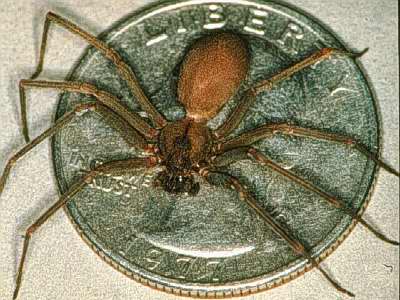
Allow me to introduce another native Arizonan menace: the Brown Recluse Spider. These spiders probably got their name due to their ?brown? coloring and ?reclusive? nature. I, for one, have never met an especially bold spider. I?ve never had a spider single me out of a crowd and walk right up to me, saying, ?Yeah, buddy, I?m talkin? to YOU!? That?s why so few of them become professional boxers. I suppose it?s hard to be assertive when your mortal enemy is a tightly rolled People magazine. Leave it to the scientific community, though, to give the thing such a dull, literal name, especially in light of what it can do. A brown recluse bite causes something known as (and this is the actual term for it, no lie) a ?volcano lesion,? which is a raised lesion with a discernable opening that can range in size from ?an adult?s thumbnail to the span of a hand.? I?d have called the Brown Recluse the ?Non-Speckled Whooping Volcano Lesion Spider,? but I wasn?t consulted. I?m petitioning the Arachnological Society for a name change, but I?ve only gathered 7 signatures, and I suspect a couple of them, Philip DaGraves and Amanda Hugginkiss, are phony.
The venom from a brown recluse actually kills the flesh it encounters, leaving gaping, gangrenous wounds that take months to heal and leave the type of scarring you?d expect from gaping, gangrenous wounds. There is no known effective antivenom, and in some cases bite victims are treated with Dapsone, a drug chiefly used to treat leprosy. If you want to gross yourself out some time (And really, who doesn?t?), google up some pictures of Brown Recluse bites. It?s disgusting, exploitive, and educational!
Since this reclusive spider is brown, it?s hard to spot in its outdoor desert habitat. Aside from the cactus, everything in Arizona is brown. However, ?They thrive in human-altered environments. Indoors, they may be found in attics, basements, crawl spaces, cellars, closets, and ductwork or registers. They may seek shelter in storage boxes, shoes, clothing, folded linens, and behind furniture.? Many victims are bitten when they roll over onto the spider while they sleep. Severity of the bite, as with all things brown, hairy, and venomous, depends on the amount of venom the spider manages to inject. And when you?re squashing one, chances are you?re going to get all it?s got.
So how best to avoid being bitten? Constant vigilance!
? Shake out clothing and shoes before getting dressed. ?Raid? makes an excellent antiperspirant.
? Inspect bedding and towels before use.
? Wear gloves when handling firewood, lumber, and rocks (be sure to inspect the gloves for spiders before putting them on). Be sure to inspect firewood, lumber, and rocks for spiders before handling. Be sure to check your hands for spiders before putting your hands into spider-free gloves. If you find a spider, inspect it for spiders.
? Remove bed skirts and storage boxes from underneath beds. Move the bed away from the wall. Dig a wide moat around the bed and fill it with boiling oil.
? Exercise care when handling cardboard boxes (Recluse spiders often are found in the space under folded cardboard flaps). Remember to always lift with your knees, not with your back.
I have to admit I?ve always been lax about inspecting my bed before I get into it. Usually I just make sure I?m not jumping in on top of the cat, who, at 14 roly-poly pounds, is pretty easy to spot, even if she is brown and reclusive. I enjoy getting out of the shower and drying off without carefully examining my towel, and putting on my shoes with little more thought than making sure I?ve got the left shoe on the left foot? which makes me a prime target for attack, not only from the Brown Recluse, but from...
Part 3
Scorpions, The
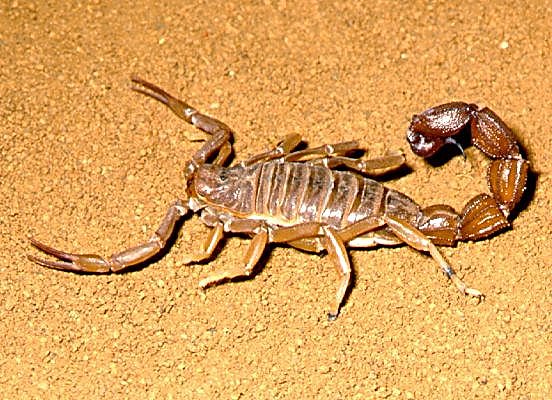
Another hedonistic luxury I?ve long taken for granted is shamelessly walking around in the middle of the night without shoes on. I?m a wild and crazy guy that way, and I don?t care who knows it. This is another Arizona no-no, not so much because of our friend the Brown Recluse, but because of his nocturnal cousin, the scorpion. Many people are stung by scorpions by accidentally stepping on them in the dark. Scorpion stings are usually far less traumatic than Brown Recluse stings, and are often compared to a bee sting, but not an attack by a swarm of killer bees, which, as we?ve discussed, is much, much worse. Two of the 90 species of scorpion native to Arizona are dangerously venomous, but you still don?t hear about people dying from them. Naturally, I suspect another cover-up.
What does make the scorpion worse than a Brown Recluse Spider, though, is that scorpions are much, much creepier in appearance. They?re some kind of demonic cross between an Earwig, a miniature lobster, a spider, and a bee. They?re the worst of all worlds.

My online research attempts on the scorpion were frequently thwarted by many a misdirected detour to fan sites devoted to the Scorpions, a heavy-metal rock band popular in the 80?s, best known for the immortal lyrics, ?Here I am! Rock you like a hurricane!? They are the ?best rock band ever,? according to one Gilbert G. Morton, a ?computer hardware engineer? from Houston, Texas, and webmaster of www.scorps.com. Mr. Morton would like all you single ladies out there to know that, shockingly enough, he is single, ?so get the email a coming.? Ladies interested in courting Mr. Morton can find his photo and a brief bio here: http://www.scorps.com/per.html.
Scorpions are arachnids, close relatives of ticks, mites and spiders. There?s a family reunion barbeque I?d rather not attend. It?s a little too similar to going back to Jeffrey Dahmer?s apartment for a nightcap. Partying with anything or anyone who wants to eat you is just plain silly. Just ask John Williams and James Harris, missionaries from London who traveled to the island of Erromanga in the year 1839, and, ?were killed and eaten by cannibals, only minutes after going ashore.? Strangely enough, this event caused the Catholic Church to proclaim that the island had been ?baptized by the blood of martyrs; and Christ thereby told the whole Christian world that he had claimed these islands as his own.? Leave it to the Church to snatch victory form the very literal jaws of that defeat, but what can you expect from a religion that encourages its followers to gnosh on the transubstantiated body of Christ himself? My point? It?s too late for me to save John Williams, James Harris, or Christ, but if this blog helps to prevent just one person from being digested by another person, or stung by a scorpion, it will have been worthwhile.
Scorpions (the arachnids, not the rock band) have ?two to five pairs of eyes,? but yet ?they do not see well.? There?s evolution at work for you. Some species can live as long as 25 years, but your more typical scorpion lives for three to eight years. They range in size from half an inch to up to eight inches long.
Scorpions have an ?elaborate mating process, which lasts from 24 to 36 hours.? Far from a mere romantic dinner and moonlit stroll along the beach, the ritual involves the male and female scorpion grabbing hold of each other?s pincers and running around in circles for hours on end, often singing ?I Could Have Danced All Night.? The romantic dinner comes later, after the pair has retired to the boudoir and ?done the nasty,? at which time the female will devour the male. It has been suggested that reason they spend so much time going in circles is that the male knows he?s Michael Douglas in ?Fatal Attraction? and is trying to postpone the inevitable. This is why it?s always better to wait until you really, really know someone before sleep with them, and why you should always have a preplanned escape route.
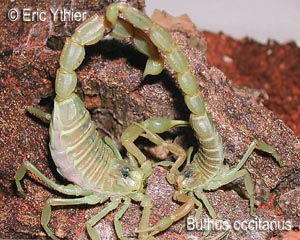
Scorpions routinely infest homes, especially newer homes built in previously undeveloped areas. They come up through pipes, and crawl in through vents and windows. They lurk in the usual dark out of the way places, and, like the Brown Recluse, can turn up in your linens, clothing, and shoes. One website suggested putting the legs of your bed inside glass jars, as scorpions cannot crawl up glass surfaces. Another suggested wrapping the legs in duct tape, sticky side out. The Discovery Channel featured one woman who routinely caught five to ten scorpions on glue traps set out in her bathroom every night. I think I?d rather live in precarious denial than be confronted with that squirming mess every morning. What a way to start your day. Yuck.
Scorpions glow under black light. Isn?t that vile? Would you expect less from them? They?re also nocturnal; hence the advice to never make that journey from bed to the bathroom in the middle of the night without adequate footwear. Remember, too, to check said footwear for any scorpions which may be lurking inside. I?d say the whole thing makes a perfect argument for resurrecting the chamber pot, but in all likelihood scorpions would lurk in there, too. You just can?t win when it comes to these little devils. I?ve read that having a cat or two around will greatly reduce any home?s scorpion population. Apparently, if you?re a cat, eating scorpions can be a heck of a lot of fun, but the cats ?must be carefully trained to do so!? I?d sincerely like to meet anyone successful in training a cat to spar with an insect. I?ve also read that if you don?t want a cat around the house, you might consider throwing a couple of chickens in the yard. This will attract wolves and coyotes, but at least they can?t get in through the drain in your bathroom sink, so it?s arguably a valid solution.
Part 4
Snakes, Rattle
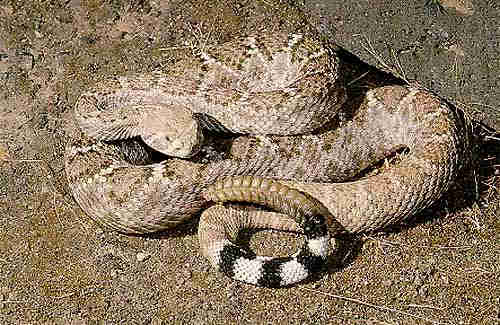
Toward the program?s end, we were treated to special segment wherein firefighters were called out to retrieve a rattlesnake from a Scottsdale resident?s perfectly manicured front lawn. Arizona, it turns out, is home to over 72 varieties of snake, 14 of which are rattlesnakes. Arizona?s baseball team is named after the granddaddy of all rattlesnakes, the Western Diamondback, which can grow to 5 feet long. Fifteen people die every year from snake bites. Between June 1997 and April 1998, one hospital treated five people who were bitten by rattlesnakes after the snakes had been killed and even decapitated. Don?t believe me? Follow this ridiculously long URL and read it for yourself:
http://www.bannerhealth.com/patients+and+visitors/facilities/arizona/poison+center/desert+critters/_rattlers+still+bite.asp
Statistics tell us that 80% of people who get bit are males under the age of 30 who think rattlesnakes are playthings. Often, alcohol is involved. There are no bad rattlesnakes, only bad drunk people. 25% of rattlesnake bites are ?dry bites,? meaning that the snake, while annoyed enough to bite you, would rather not waste his time injecting you with venom. Baby rattlesnakes, though, have not yet mastered the art of venom control, and their bites contain the most venom and are the most lethal. Under no circumstances should you tickle a baby rattler?s chin and say ?Kootchie kooticie koo,? no matter how sweet the little darling looks in his stroller. The remaining 20% of bites occur when people blindly step on the snakes, or reach into the mysterious depths of some dark outdoor hole or crevice, thereby ruining Sheldon the Snake?s surprise party.
8,000 people in the US receive venomous rattlesnake bites every year. It?s actually pretty fortunate that only 9 to 15 of those people die. Rattlesnake venom not only contains a powerful neurotoxin that causes paralysis and death, it also contains digestive enzymes that begin to break down (digest, if you will) tissue. The snake is effectively eating you before it eats you. Reminds me of our friend the Brown Recluse. Wanna gross yourself out some more? (You know you do!) Google up some pictures of rattlesnake bites. Aside form the obvious pain and nasty puncture marks; there is an unbelievable amount of swelling. This swelling is often alleviated by repeatedly cutting the skin over the swelling areas, since eventually the skin would split on its own. The cost for the antivenom used in the treatment alone averages $20,000, so you?re lucky if your hospital hasn?t blown its budget on an iron lung and has some lying around.
What to do if you?re bitten?
? Do not panic.
? Avoid movement and keep the area bit lower than your heart. Do not lay flat! You could lie down on a scorpion!
? Remove clothing and jewelry near the bite. Your flesh will assume a reddish-purply color that?s very hard to accessorize.
? Get to a hospital as soon as you can, but without moving or panicking. DO not assume you are okay just because the giant talking banana says so.
? Do not try to cut the bite open and suck out the poison! Who knows where that snake has been? And you will only cause more damage. This should only be done by someone that knows what they are doing and in a case where you can not get to a hospital.
? Do not use a tourniquet unless you can not get to a hospital. If you put a tourniquet on a limb, it may need to be amputated. If your face contorts in agony, it may freeze like that.
? Do not use ice or cold packs on the bite. This will make it worse, because then you?ll be cold.
Part 5
End, The

The show also introduced us to Gila Monsters (big lizards with a nasty bite), Javelinas (a wild-boar kind of thing), hissing cockroaches, and Black Widow Spiders. By then, however, we had reached a dazed state of critical overload, and I was distracted by mental images of my new life in Arizona.
There I was, stepping out into the bright sunshine of another perfectly cloudless Arizona morning, on my way check the mail. Birds tweeted and sang and the palm trees swayed in a light breeze. I was having a good hair day and singing ?Sugar, Sugar? by the Archies, as I am oft wont to do on fine mornings when I?m in a good mood.
?Oh sugar, da da da da da dum, oh honey, honey, da da da da da dum, you are my candy girl?.and you got me wantin? yooooouuu.?
As I open the mailbox and reach inside, a Western Diamondback rattlesnake drops out of nearby tree and onto my head. It sinks its fangs into my arm, the shock and surprise of which leaves me oblivious to the fact that I?ve just stuck my hand into a nest of scorpions who have taken up residence in the mailbox. As they sting my probing hand repeatedly, I attempt to shake the rattlesnake off, sending violent vibrations through the air that attract a nearby swarm of Africanized killer bees. As the undulating cloud of buzzing insects blots the horizon, I stagger toward the house, but the numbness suddenly overtaking my extremities from the venom of the snake, still attached to my arm and rattling furiously, slows me, and the swarm is upon me, repeatedly stinging every millimeter of my exposed flesh. I make it to the door, open it, and manage to get inside, thereby reducing the swarm to hundred or so of the bees which now infest my house.
Reeling from venom, I collapse?onto a brown recluse spider. Oh no! How could it get any worse? I drag myself toward the telephone in the kitchen with superhuman strength and determination, snake still rattling, bees still buzzing and stinging, volcanic lesions erupting. I must get help! But wait, there?s a javelina in the kitchen! How did that get in here? Does it matter? Snorting wildly, the javelina charges, viciously head-butting me and bearing its long, sharp fangs, which glisten with the blood of a previous kill! This looks like the end! And all for the electric bill and some coupons from Pizza Hut addressed to ?Occupant.?
As of now, we?ve been residents of Arizona for well over a year. I?ve seen a chipmunk, small lizards, and many hummingbirds. A couple of ducks briefly invaded our pool, and Dougal had a debacle involving a ducking. The dogs have twice delivered us carcasses of dismembered pigeons and have been confused by our reluctance to accept a ?kiss? from them afterward. That?s about it for native wildlife. I don?t want to go as far as to say that I?m disappointed, but after all that research I was kind of looking forward to a disaster to avert. Actually, I just wanted to proclaim in a loud authoritative voice, and from a safe distance, ?DO NOT PANIC!? Naturally, these disasters would be befalling other people, and after my initial proclamation warning of the dangers of panicking, my role in the imagined event becomes hazy, and my mind skips forward to the scantily clad survivors thanking me in ways unsuitable for this blog.
No, there are no javelinas in the kitchen. These are no scorpions in my mailbox or in my bed. My feet remain unfettered during nighttime excursions, and aside from the occasional stubbed toe, I?ve never suffered for it. While I have seen scorpions and rattlesnakes, they?ve been safely encased in clear acrylic made into paperweights or belt buckles. If there are any Brown Recluses in our house, they?ve earned their droll scientific name by remaining ultimately reclusive. This isn?t to say we?ve let our guard down completely. There?s a birdhouse hanging odd the eaves in the back of the house. Shawn often looks up at it, wondering aloud what might actually be nesting in there, since we?ve never seen a bird anywhere near it.
There is no evidence to suggest the birdhouse is occupied by tarantulas, scorpions, or spiders. There?s no evidence to suggest it isn?t. Either way, we?re not looking.
Posted by johnfrommelt
at 8:08 PM
Updated: Thursday, 9 June 2005 9:05 PM












 “Hi, I’m Cloe and I rock! My friends call me ‘Angel’ because that’s what I am!”
“Hi, I’m Cloe and I rock! My friends call me ‘Angel’ because that’s what I am!”


